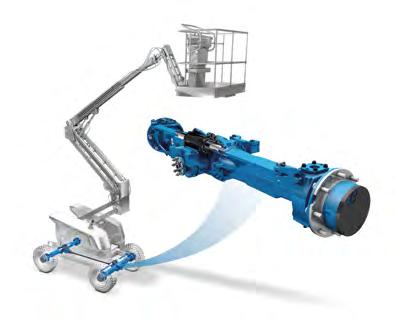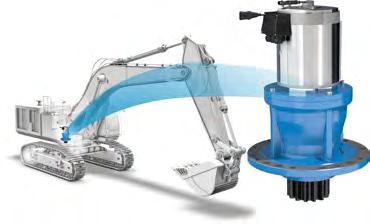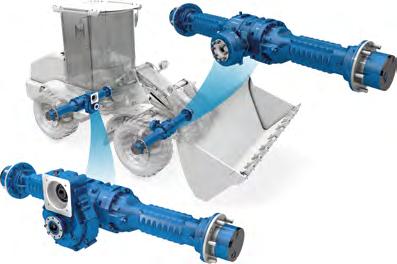
6 minute read
TOWARD LOWER ENVIRONMENTAL IMPACT: THE REDUCTION OF CONSUMPTION AND LUBRICANTS
One example of how lower environmental impact and reduced fuel consumption can be achieved through eco-design is the 2400- and 2500-series PTO driveshafts, in which functional performance has been improved without increases in weight and size through new advanced calculation methods.
Furthermore, using the Walterscheid Connected Service app, the Digital Twin 10 project provides the user with a tool to grease the driveshaft using the correct amount of grease depending on the size, hours of operation, and type of application, thus reducing the amount of lubricant used during the life of the driveshaft and the frequency of routine maintenance.
10 - Digital Twins are used for a variety of purposes, particularly in design, manufacturing, and predictive maintenance, as they allow the behaviors of an element in the physical world to be simulated with great accuracy in a digital environment. It is for all intents and purposes a virtual "twin" of its physical equivalent, be it an object, process, person, system, or device. According to Gartner – one of the world's leading analysts in technology – it is one of five emerging trends that will drive technological innovation for the next decade.
Another example is the Mobile Elevating Working Platform (MEWP), for which Comer Industries has introduced a new architecture for power transmission through the introduction and development of the P-Series axle line, which has led to greater efficiency of the entire transmission system.

Today this innovative and more efficient architecture can also be used on larger aerial platforms thanks to the combination of the new P20 axle with an electric drive train. Designed and developed specifically for aerial platforms with a reach of 20 to 25 meters, the P20 axle enables efficiency and a consequent reduction in the total cost of the machine of at least 30% compared with architectures currently on the market.
In the construction equipment sector, Comer Industries continues its efforts to develop more compact, lighter, and higher power density transmissions for the Planetary Drives segment for the crawler excavator market.
Building on its experience in high-end excavator rotations, Comer Industries has expanded its offerings with the new PG1500 EX, developed specifically for the 20-ton machine segment and made with 20% less weight than the previous version. Since this segment has the largest market volumes, a positive environmental impact can be assumed in terms of both energy savings and CO2 not emitted into the environment.
Currently the crawler excavator industry is evolving toward electrified powertrains. With this in mind, the PG1500 EX, initially developed for hydraulic traction, is already designed for a high-voltage electric drive.
Solutions For Machine Electrification

In addition to the initiatives and activities undertaken at the level of design and manufacture of its products, the Company is engaged in numerous collaborations with customers to further reduce its impact on emissions and the environment in general through zero-emission mobility applications.
These include the pilot project conducted with Lohr Industries (France) to test an autonomous i-Crystal shuttle equipped with AC3300iAAR3700i homokinetic driveshafts. The i-Crystal autonomous shuttles are 100% electric and are highly scalable, making it possible to offer a supply proportionate to demand to optimize transportation resources and reduce waste.
The collaboration with Rosenbauer International AG (Austria), on the other hand, led to the creation of the Concept Fire Truck CFT electric firefighting vehicle prototype, equipped with CV-series constant velocity drive shafts. By combining these shafts with several other innovative technologies, the new concept offers an increased level of safety, excellent maneuverability and driving dynamics, and integral networking, all of which streamline use while reducing fuel consumption and waste.
To capitalize on the rapid growth in demand for compact electric vehicles and meet their challenging efficiency targets, Comer Industries has extended the operating range of the previous transmission to 6,000 rpm with the new I-S428 HS The new generation of electric transmissions allows offering components with improved capacity and the possibility of increasing the maximum input speed up to 9,000 rpm.
Requiring no forced lubrication, this technology also avoids the use of oil and reduces noise emission by 25%.

Commitment And Responsibility Throughout The Product Life Cycle
Starting from the product development stage and then continuing throughout the life cycle, the Company follows a process aimed at the responsible management of all aspects related to sustainability. Special attention is paid to compliance with all national and international standards applicable in the various target markets, as well as to meeting contractual requirements and technical specifications. Furthermore, the process aims to achieve the highest standards of user safety, minimize environmental impacts, and achieve full supply chain involvement.
A commitment that is expressed in the Product Quality, Sustainability, and Responsibility Policy published in 2022 and available on the Company’s website.
Compliance with the regulatory framework applicable to the products sold (such as the Machinery Directive 2006/42/EC, Regulation 1907/2006/EC REACH RoHS Directive) is a prerequisite that is therefore assessed in advance, as early as the feasibility study stage. In this regard, Comer Industries relies on a central function with internally developed application know-how, as well as decentralized competence centers to better oversee the specifics of each market.
During the product design phase, Comer Industries applies methods for the preventive assessment of potential failures (DFMEA) to all products. The methods identify characteristics that impact security and measures to mitigate risks, anticipating any critical issues that could compromise their safe use or reliability. During manufacturing, these characteristics are managed in such a way as to minimize the probability of failure through anti-error or automatic control systems.
Advanced testing and simulation systems are then used in the Testing and Validation Centers situated in various locations. Following the acquisition of Walterscheid, the Testing and Validation Area saw substantial structural growth from the original 2,100 square meters located at the Reggiolo site to the current 5,960 square meters now also at the Monguelfo, Lohmar, and Rockford sites, with a total of 60 main testing stations and a staff of 28 specialized technicians.
The centers conduct functional, endurance, and fatigue tests according to the validation criteria set for each type of system, and in the specific case of gimbals in the agricultural sector for the purpose of type approval according to the Machinery Directive. A total of 100,000 test hours were passed in 2022.
The Company constantly checks the performance and quality levels of its products against the preset targets, by monitoring specific performance indicators, checking semi-finished and finished products and conducting process audits inside and outside its production plants. To this end, digital systems that accelerate and automate data collection, management reporting and analysis to focus efforts on problem solving and prevention are available.
Customer satisfaction is monitored through consultation of digital platforms for sharing information and any type of communication received in order to promptly manage any deviations or signs of deviation in performance.
Any non-conformities detected internally or reported by customers are received, prioritized through criteria based on the evaluation of potential impacts, and addressed with problem solving methods (such as 8D or DMAIC), aimed at the definitive elimination of the causes of the problem and the extension of the solutions to other potentially affected products. Methods and procedures are integral parts of the Quality Management System, developed according to the ISO 9001:2015 standard, extended globally and certified by accredited bodies.
Comer Industries is progressively integrating the assessment of environmental and social impacts of products within its development processes, gradually optimizing performance. The Company has developed a method for mapping and evaluating the materials used in components and manufacturing processes: the system makes it possible to determine product characteristics related to chemical composition, percentages of recycled material, and levels of downstream recyclability. The goal is to verify compliance with regulatory and contractual product requirements, gradually reduce the use of hazardous substances, and improve the environmental footprint. The data used are provided by the component suppliers themselves, or alternatively from sources found in industry literature.
Product Circularity
In continuity with the project started in 2021 on a specific family of products in the wind energy sector, during the last financial year the study was extended to double joints used in the agricultural sector.
The results gathered in 2022 in combination with previously studies show that 28% of the product is composed of material from recycling, while an average of 95% of the delivered product is recoverable.
Initiatives directed at reducing environmental impacts are not just about the product. With a collaborative approach based on shared goals with customers, the Lohmar production site promoted packaging rationalization and optimization, eliminating disposable wooden packaging and replacing most of it with returnable packaging. As a result of the substitution, which involved about 30% of the wood packaging, the impact associated with waste generation was reduced and the logistical flow in coordination with customers was facilitated.
For the manufacturing process of the same product additional changes led to an increased use of recycled plastic for the protective components of the gimbals and the replacement of paper labeling and documentation with laser markings. Finally, for customers requiring paper documentation, recycled paper was used for the operation and maintenance manuals.








